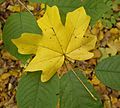Foliage (botany)
Foliage is a term used in botany and describes the entirety of the leaf organs of deciduous trees and shrubs .
Foliage leaf
Foliage leaves are characterized by a large leaf area (leaf blade) in relation to the leaf thickness and by a network of veins . (In contrast, the needles of conifers are leaves with parallel veins and a small leaf area. See also leaf (plant) . )
Foliage as animal feed
Foliage can both fresh ( green fodder ) and dried ( roughage being fed to sheep and goats). Foliage is rich in minerals. If care is taken to keep the leaves green during drying, then it is just as good fodder for sheep as hay . The foliage was cut off with the branches either ( schneiteln ) and fed both, or the branches remained on the tree and the leaves were stripped and fed only these. The Schneitelwirtschaft served the cultivation, the maintenance and the use of fodder trees. Common forage trees were ash and elm . At the end of the 19th century, there were still 850,000 hectares of deciduous meadows in Estonia with snowmaking.
In the aquarium hobby , leaves are used as food for shrimp ( Caridea ).
Leaf fall

In times of the year with little water supply, many deciduous trees shed their leaves in order to reduce water loss through evaporation from the leaf surface. This is the case in the temperate climates in winter and in the Mediterranean in summer . When the soil cools down increasingly in the autumn nights, the roots absorb less and less water. Finally, near freezing point, water absorption is completely stopped. However, as the leaves continue to evaporate water, the tree would eventually dry out. By shedding the leaves, evaporation is severely restricted. Foliage leaves that show little evaporation due to their construction are not shed during the dry season (example: bay tree ).
Since the needle leaves are already adapted to dry locations, they are usually not thrown off during the dry season . The larch, on the other hand, loses its needles in autumn because its protection against evaporation is insufficient. The chemical processes involved in shedding plant parts are dealt with in the article Abscission , see also Senescence in plants . A layer, the so-called cork layer, corks between the leaf and the tree. As a result, the leaf can no longer be supplied and falls off. Tools such as rakes and leaf blowers can be used to collect leaves . For legal problems with leaf fall, see also: Leaf rent .
Chemical-biological causes for the change in color of the leaves

In autumn, as the day length decreases, the deciduous trees initiate the active change of color of the leaves by breaking down their proteins and storing valuable nutrients such as nitrogen and phosphate in storage tissues until the next growing season. However, the leaf pigments are not recycled. The green chlorophyll is converted into colorless forms and accumulated in the vacuoles of the cells, so that the chlorophyll-containing proteins can also be broken down during photosynthesis . It reveals the remaining yellowish-red carotenoids . The logistics of the shifting of the material is often clearly recognizable in the leaf: peripheral areas lose their green first, it remains longer along the leaf veins .
In many species there is also a strong red color. This is primarily due to the dye anthocyanin , which is newly synthesized with the use of energy. Carotenoids are also produced. The purpose for this is unclear; the strong coloration may serve to deter insects that want to lay their eggs on these plants, or as a protective reaction of the chloroplasts that are still active against too much radiation. It is unclear why North American deciduous tree species often produce a stronger red color than their European relatives.
Natural benefits of foliage
Autumn leaves protect plants from cold, moisture and wind. Leaves decompose over the course of months and ultimately become nutrient-rich soil, the ingredients of which can be absorbed by plants and used for growth. In addition, a layer of leaves offers protection and shelter for animals and insects.
Leaf layer
Many soil organisms such as earthworms , woodlice , mites , springtails and microorganisms live in the leafy layer . They break down the leaf litter into humus .
leaves
Web links
- http://www.botanikvortrag.de/Herbstlaub_Fruchtreife.html
- Podcast Where does all the leaves go? on www.forstcast.net
Individual evidence
- ↑ Leaves as green fodder for goats, accessed on March 16, 2018
- ↑ Jost Trier : Venus. Etymologies around the forage leaves. Cologne and Graz 1963 (= Münster research , 15).
- ↑ Communications of agricultural experiences, views and principles: A handbook for farmers and cameralists, Volume 2 §155, p. 319, Albrecht Block, 1832
- ↑ Leaves as shrimp food
- ^ Philippe Matile: Biochemistry of Indian summer: Physiology of autumnal leaf coloration. (PDF; 891 kB) In: Experimental Gerontology. 35, No. 2, 2000, pp. 145-158, doi : 10.1016 / S0531-5565 (00) 00081-4 .
- ^ WD Hamilton, SP Brown: Autumn tree colors as a handicap signal. (PDF; 121 kB) In: Proceedings of the Royal Society B. 268, No. 1475, 2001, pp. 1489-1493, doi : 10.1098 / rspb.2001.1672 .
- ↑ Autumn leaves - this is how you use the valuable leaves. PlantsTanzen.de, accessed on November 29, 2017 .




